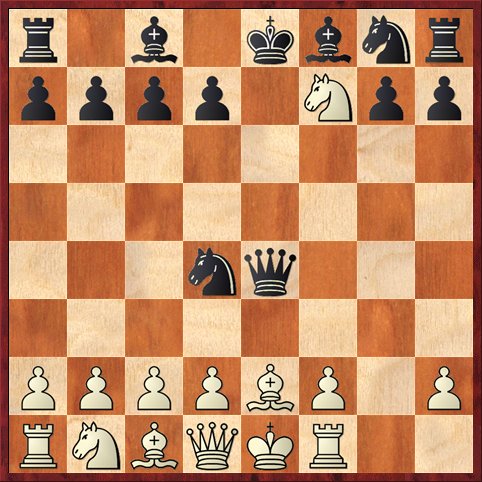Today’s chess club at the Aptos Library was one of the best I can remember. We had 18 kids, and everybody seemed to find a good match to play against. In the lesson I talked about an age-old trap:
1. e4 e5 2. Nf3 Nc6 3. Bc4 Nd4? 4. Nxe5?! Qg5 5. Nxf7?? Qxg2 6. Rf1 Qxe4+ 7. Be2 (diagram).
 FEN: r1b1kbnr/pppp1Npp/8/8/3nq3/8/PPPPBP1P/RNBQKR2 b Qkq – 0 7
FEN: r1b1kbnr/pppp1Npp/8/8/3nq3/8/PPPPBP1P/RNBQKR2 b Qkq – 0 7
Black to play and win.
First question: Does anybody know if this trap has a name? I told my kids about the Fool’s Mate and the Scholar’s Mate, but I didn’t know a name for this one. It ought to be the Greedy Person’s Mate, because White’s main sin was excessive greed (4. Nxe5 and especially 5. Nxf7).
Not too long ago I watched a lecture by Roman Dzindzichashvili about “Good Traps and Bad Traps.” This was his principal example of a bad trap, which he defined as playing an inferior move just to see if you can induce your opponent to blunder. In this case, Black’s inferior move was 3. … Nd4?, which violates opening principles and gives Black a disadvantage after either 4. Nxd4 (Dzindzi’s recommendation) or even 4. c3. Black is just rolling the dice and hoping that White will play 4. Nxe5, which admittedly is a tempting move. Dzindzi’s disdain (or perhaps I should say “dzisdzain”) for anyone who would play this way as Black was palpable.
But even if it’s a bad trap, it’s a great lesson! Any game this extreme can teach beginning players a lot. First, there are many important tactical themes. There are forks (4. … Qg5 and 5. Nxf7), almost back-rank mates (6. Nxh8 Qxh1+), pins (the pinned bishop on e2 in the diagrammed position, and finally the exquisite smothered mate that ends the game (7. … Nf3 mate).
I can tell you that the kids were really excited to discover all these things and especially the smothered mate, which really comes as a bolt from the blue if you’ve never seen this trap before. But for me, the best moment came right at the very end, when I was trying to sum the lesson up and explain why White lost.
Here’s the thing. In any given lesson, about a third to a half of my students actually don’t participate. And it’s okay with me if, out of 18 kids, only 9 of them actually give me answers. The reason it’s okay is that we always have a range of people from absolute beginners to regulars who have been coming to the club for a year or two. It’s only natural that somebody who has only come two or three times will be a little bit hesitant to speak up. I let them decide for themselves when the time is right.
So I was very curious when one of our newest participants, a girl named Cora who had never spoken up before, raised her hand. I eagerly called on her.
“Because no matter how many points ahead you are, they don’t count,” she said. “You could have a million points and still lose!”
It’s fair to say that my jaw hit the floor. I couldn’t have summed the lecture up better myself. It was both a chess lesson and a life lesson, and she aced it! I couldn’t have been prouder of her.



{ 4 comments… read them below or add one }
“In any given lesson, about a third to a half of my students actually don’t participate. ”
I run into this in my college classes too, when I am lecturing. Here’s some things that I tried that worked for me.
q. 1 Do you give your kids any incentives to participate? Perhaps giving out a small piece of candy or a marble, (really just about anything can be a used as symbol of excellence) once in a while for an exceptional comment might work.
q. 2 Have you tried having them work in pairs? It would seem like this would help get them to talk.
q. 3 Do they get a chance to talk and meet each other before the lesson starts? Maybe they are shy and some social interaction would help loosen them up.
q. 4 Do you know why they are not participating? Is it fear, shyness, boredom, lack of knowledge, or some other factors? I don’t have any concrete suggestions for how you would figure this out, aside from asking them individually, and even then they might not know themselves why they don’t participate.
I’m not criticizing, just sharing some ideas. Your approach seems quite reasonable under the circumstances.
Great comment by Cora, BTW. I loved it.
Mike
When my college students flatly won’t venture any answers, I sometimes resort to “Talk about it with your neighbor for a minute” followed by “Someone tell me your neighbor’s goofy idea.” This often breaks the logjam.
Another version that might work well with kids is “No good ideas? Okay, someone tell me a *bad* idea. A really bad idea!”
Thanks, Mary and Mike! I like Mary’s second idea… Actually, I have tried that in the past and it does help get discussion going. All in all, I’m really not too worried about the participation rate, because my frame of reference is college mathematics, which I used to teach. There I would be lucky to get a 10 percent participation rate. So when 50 percent of the kids at chess club are waving their hands and clamoring to answer, I’m just thrilled.
The opening is called the ‘Blackburne Shilling Gambit’, not sure if the specific trap in it has a name.
http://en.wikipedia.org/wiki/Italian_Game,_Blackburne_Shilling_Gambit